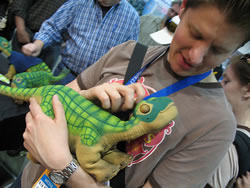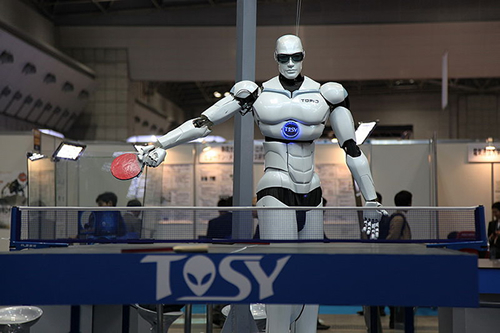That is genuinely really really weird. I don't like it. Think it's going to get into my nightmares. Some scary shizzle.
Life Like Robots
 Robotic engineers are designing the next generation of robots to look, feel and act more human, to make it easier for us to warm up to a cold machine.
Robotic engineers are designing the next generation of robots to look, feel and act more human, to make it easier for us to warm up to a cold machine.Realistic looking hair and skin with embedded sensors will allow robots to react naturally in their environment. For example, a robot that senses your touch on the shoulder and turns to greet you.
Subtle actions by robots that typically go unnoticed between people, help bring them to life and can also relay non verbal communication.
Artificial eyes that move and blink. Slight chest movements that simulate breathing. Man made muscles to change facial expressions. These are all must have attributes for the socially acceptable robots of the future.

The brain behind the beauty will be the key to turning a realistic looking machine into a life like robot. AI plays a pivotal role in successful human/robot interaction.
Rescue Robots
Imagine yourself lost deep in the forest on a cold autumn night and nightfall is rapidly approaching. Too windy for search aircraft and too dark for ground teams, this could be a life threatening situation. Fortunately for you, it is ten years into the future and hundreds of tiny intelligent robots will be combing the woods for you throughout the night.
All terrain robots (ATRs), will truly function as a team by sharing their locations, discoveries, search patterns and more. Large ATRs could carry many smaller robots and provide them with localized control and power.
These smaller more specialized robots will have cameras, sonar, heat sensors, motion detectors and can be sent out by the large ATRs as needed. Smaller robots might work together to perform tasks such as moving a large obstacle.
Wikipedia extract
Types of robots
Humanoid robots:
- Lara is the first female humanoid robot with artificial muscles (metal alloy strands that instantly contract when heated by electric current) [1] [2] instead of electric motors (2006).
- Asimo is one of the most advanced projects as of 2009.
Modular robots: can be built from standard building blocks that can be combined in different ways.
- Utility fog
- M-Tran - a snake-like modular robot that uses genetic algorithms to evolve walking programs
- Self replicating robots [3] [4] - modular robots that can produce copies of themselves using existing blocks.
- Swarmanoid [5] [6] is a project that uses 3 specialized classes of robots (footbots, handbots and eyebots) to create an effective swarm. Such swarm should be able, for example, tidy a bedroom with each robot doing what it is best at.
- Self-Reconfiguring Modular Robotics
Educational toy robots:
Sports robots:
[edit]Applications
- Caterpillar plans to develop remote controlled machines and expects to develop fully autonomous heavy robots by 2021 [7]. Some cranes already are remote controlled.
- It was demonstrated that a robot can perform a herding [8] task.
- Robots are increasingly used in manufacturing (since 1960s). In auto industry they can amount for more than half of the "labor". There are even "lights off" factories such as an IBM keyboard manufacturing factory in Texas that are 100% automated[1].
- Robots such as HOSPI [9] are used as couriers in hospitals, etc. Other hospital tasks performed by robots are receptionists, guides and porters helpers, [10] (not to mention surgical robot helpers such as Da Vinci)
- Robots can serve as waiters [11] [12] and cooks [13].
[edit]Market evolution
Today's market is not fully mature. One or more software compatibility layers have yet to emerge to allow the development of a rich robotics ecosystem (similar to today's personal computers one). The most commonly used software in the robotics research are Free Software solutions such as Player/Stage or cross-platform technologies such as URBI. Microsoft is currently working in this direction with its new proprietary software Microsoft Robotics Studio. The use of open source tools helps in continued improvement of the tools and algorithms for robotic research from the point one team leaves it.




No comments:
Post a Comment